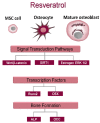Effects of Extracellular Osteoanabolic Agents on the Endogenous Response of Osteoblastic Cells
- PMID: 34572032
- PMCID: PMC8471159
- DOI: 10.3390/cells10092383
Effects of Extracellular Osteoanabolic Agents on the Endogenous Response of Osteoblastic Cells
Abstract
The complex multidimensional skeletal organization can adapt its structure in accordance with external contexts, demonstrating excellent self-renewal capacity. Thus, optimal extracellular environmental properties are critical for bone regeneration and inextricably linked to the mechanical and biological states of bone. It is interesting to note that the microstructure of bone depends not only on genetic determinants (which control the bone remodeling loop through autocrine and paracrine signals) but also, more importantly, on the continuous response of cells to external mechanical cues. In particular, bone cells sense mechanical signals such as shear, tensile, loading and vibration, and once activated, they react by regulating bone anabolism. Although several specific surrounding conditions needed for osteoblast cells to specifically augment bone formation have been empirically discovered, most of the underlying biomechanical cellular processes underneath remain largely unknown. Nevertheless, exogenous stimuli of endogenous osteogenesis can be applied to promote the mineral apposition rate, bone formation, bone mass and bone strength, as well as expediting fracture repair and bone regeneration. The following review summarizes the latest studies related to the proliferation and differentiation of osteoblastic cells, enhanced by mechanical forces or supplemental signaling factors (such as trace metals, nutraceuticals, vitamins and exosomes), providing a thorough overview of the exogenous osteogenic agents which can be exploited to modulate and influence the mechanically induced anabolism of bone. Furthermore, this review aims to discuss the emerging role of extracellular stimuli in skeletal metabolism as well as their potential roles and provide new perspectives for the treatment of bone disorders.
Keywords: antioxidant supplements; bone remodeling; exosomes; mechanically induced anabolism; ossification stimuli; osteoanabolic agents; osteoporosis; resveratrol; retinoic acid; zinc.
Conflict of interest statement
There are no potential conflict of interest relating to the manuscript for each author, and there were no extramural sources supporting this research (excluding sources already declared).
Figures









Similar articles
-
The Wnt co-receptor LRP5 is essential for skeletal mechanotransduction but not for the anabolic bone response to parathyroid hormone treatment.J Biol Chem. 2006 Aug 18;281(33):23698-711. doi: 10.1074/jbc.M601000200. Epub 2006 Jun 20. J Biol Chem. 2006. PMID: 16790443
-
Studies on the mechanisms of the skeletal anabolic action of endogenous and exogenous parathyroid hormone.Arch Biochem Biophys. 2008 May 15;473(2):218-24. doi: 10.1016/j.abb.2008.03.003. Epub 2008 Mar 10. Arch Biochem Biophys. 2008. PMID: 18358824 Review.
-
microRNA-103a functions as a mechanosensitive microRNA to inhibit bone formation through targeting Runx2.J Bone Miner Res. 2015 Feb;30(2):330-45. doi: 10.1002/jbmr.2352. J Bone Miner Res. 2015. PMID: 25195535
-
A novel quercetin analogue from a medicinal plant promotes peak bone mass achievement and bone healing after injury and exerts an anabolic effect on osteoporotic bone: the role of aryl hydrocarbon receptor as a mediator of osteogenic action.J Bone Miner Res. 2011 Sep;26(9):2096-111. doi: 10.1002/jbmr.434. J Bone Miner Res. 2011. PMID: 21638315
-
Osteoblast recruitment to sites of bone formation in skeletal development, homeostasis, and regeneration.Birth Defects Res C Embryo Today. 2013 Sep;99(3):170-91. doi: 10.1002/bdrc.21047. Birth Defects Res C Embryo Today. 2013. PMID: 24078495 Review.
Cited by
-
Mechano-induced cell metabolism disrupts the oxidative stress homeostasis of SAOS-2 osteosarcoma cells.Front Mol Biosci. 2024 Apr 25;10:1297826. doi: 10.3389/fmolb.2023.1297826. eCollection 2023. Front Mol Biosci. 2024. PMID: 38726050 Free PMC article.
-
Cyclic Stretch-Induced Mechanical Stress Applied at 1 Hz Frequency Can Alter the Metastatic Potential Properties of SAOS-2 Osteosarcoma Cells.Int J Mol Sci. 2023 Apr 22;24(9):7686. doi: 10.3390/ijms24097686. Int J Mol Sci. 2023. PMID: 37175397 Free PMC article.
-
Microtomographic, Histomorphological, and Histomorphometric Analysis of Bone Healing in the Midpalatal Suture After Treatment with Isotretinoin.Dent J (Basel). 2025 Mar 25;13(4):142. doi: 10.3390/dj13040142. Dent J (Basel). 2025. PMID: 40277472 Free PMC article.
-
Multi-Anticancer Activities of Phytoestrogens in Human Osteosarcoma.Int J Mol Sci. 2023 Aug 28;24(17):13344. doi: 10.3390/ijms241713344. Int J Mol Sci. 2023. PMID: 37686148 Free PMC article. Review.
-
Emerging therapeutic strategies targeting bone signaling pathways in periodontitis.J Periodontal Res. 2025 Feb;60(2):101-120. doi: 10.1111/jre.13326. Epub 2024 Jul 23. J Periodontal Res. 2025. PMID: 39044454 Free PMC article. Review.
References
Publication types
MeSH terms
Substances
LinkOut - more resources
Full Text Sources
Medical

